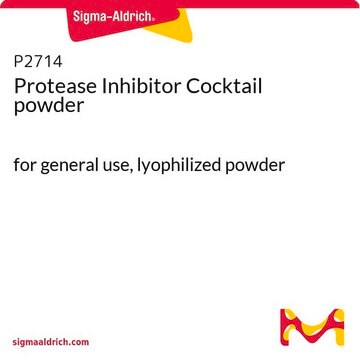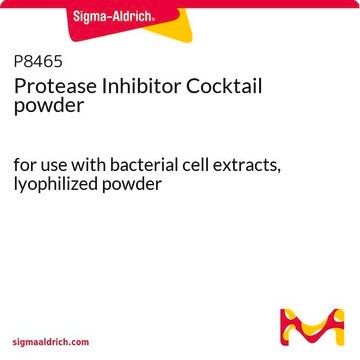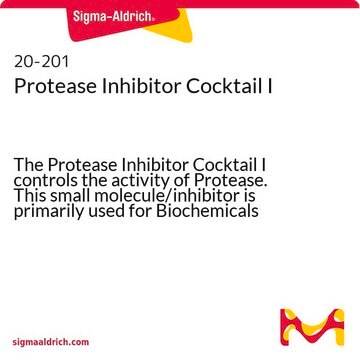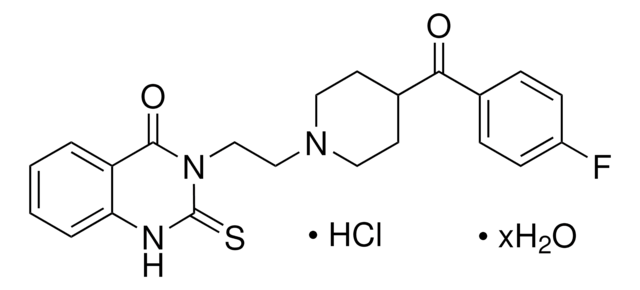SRE0055
Protease Inhibitor Cocktail Powder
Reagents designed and manufactured under cGMP controls suitable for use in an IVD application.
Synonim(y):
Protease Inhibitor Cocktail powder
Zaloguj sięWyświetlanie cen organizacyjnych i kontraktowych
About This Item
Kod UNSPSC:
12352200
NACRES:
NA.32
Polecane produkty
pochodzenie biologiczne
bovine lung
yeast
Formularz
lyophilized powder
temp. przechowywania
−20°C
Szukasz podobnych produktów? Odwiedź Przewodnik dotyczący porównywania produktów
Specyficzność
Inhibits serine, cysteine, and metallo-proteases.
Zastosowanie
Optimized and tested for general use.
Protease inhibitor cocktail powder has been used in immunoblotting and immunoprecipitation.
Protease inhibitor cocktail powder has been used in immunoblotting and immunoprecipitation.
Działania biochem./fizjol.
This mixture contains individual components, including AEBSF at 2 mM, Aprotinin at 0.3 μM, Bestatin at 116 μM, E-64 at 14 μM, Leupeptin at 1 μM and EDTA at 1 mM. Each component has specific inhibitory properties.
AEBSF and Aprotinin act to inhibit serine proteases, including trypsin, chymotrypsin, and plasmin amongst others. Bestatin inhibits aminpeptidases. E-64 acts against cystein proteases. EDTA is an inhibitor of metalloproteases. Leupeptin acts against both serine and cystein proteases.
Protease helps to break down proteins into soluble peptides and amino acids.
AEBSF and Aprotinin act to inhibit serine proteases, including trypsin, chymotrypsin, and plasmin amongst others. Bestatin inhibits aminpeptidases. E-64 acts against cystein proteases. EDTA is an inhibitor of metalloproteases. Leupeptin acts against both serine and cystein proteases.
Protease helps to break down proteins into soluble peptides and amino acids.
Komponenty
1 bottle in serum bottle
Components
AEBSF
Aprotinin
Bestatin
E-64
EDTA
Leupeptin
AEBSF
Aprotinin
Bestatin
E-64
EDTA
Leupeptin
Ilość
One bottle makes 100 mL of cocktail, which are sufficient to the inhibition of proteases present in approximately 20 gram of cell extract.
Not all extracts contain the same levels of endogenous enzymes, and it may be necessary to adjust the volume of cocktail required.
Not all extracts contain the same levels of endogenous enzymes, and it may be necessary to adjust the volume of cocktail required.
Uwaga dotycząca przygotowania
This product is supplied as a lyophilized powder. One bottle prepares 100 mL of a cocktail solution.
Ta strona może zawierać tekst przetłumaczony maszynowo.
Hasło ostrzegawcze
Warning
Zwroty wskazujące rodzaj zagrożenia
Zwroty wskazujące środki ostrożności
Klasyfikacja zagrożeń
Eye Irrit. 2 - Skin Irrit. 2
Kod klasy składowania
11 - Combustible Solids
Klasa zagrożenia wodnego (WGK)
WGK 3
Temperatura zapłonu (°F)
Not applicable
Temperatura zapłonu (°C)
Not applicable
Wybierz jedną z najnowszych wersji:
Masz już ten produkt?
Dokumenty związane z niedawno zakupionymi produktami zostały zamieszczone w Bibliotece dokumentów.
Klienci oglądali również te produkty
Farhan Younas et al.
Biochimica et biophysica acta. Biomembranes, 1860(8), 1544-1553 (2018-05-23)
Legionella pneumophila is an aerobic and nonspore-forming pathogenic Gram-negative bacterium of the genus Legionella. It is the causative agent of Legionnaires' disease, also known as Legionellosis. The hosts of this organism are diverse, ranging from simple water borne protozoans such
Amina E Essawy et al.
PeerJ, 9, e11930-e11930 (2021-08-27)
Bisphenol A (BPA) is an endocrine disruptor to which humans are often subjected during daily life. This study aimed to investigate the ameliorative effect of astragaloside IV (ASIV) or saponins extracted from Astragalus spinosus (A. spinosus) against DNA damage and
Xianzhang Zeng et al.
Microbiome, 11(1), 204-204 (2023-09-12)
Aging is a significant risk factor for ischemic stroke and worsens its outcome. However, the mechanisms for this worsened neurological outcome with aging are not clearly defined. Old C57BL/6J male mice (18 to 20 months old) had a poorer neurological
Biology for the IB Diploma: Standard and Higher Level (2001)
Ahmed S Al-Shami et al.
Molecular and cellular biochemistry (2024-06-28)
Bisphenol A (BPA), a common endocrine-disrupting chemical, is found in a wide range of home plastics. Early-life BPA exposure has been linked to neurodevelopmental disorders; however, the link between neuroinflammation, pyroptosis, and the development of psychiatric disorders is rarely studied.
Nasz zespół naukowców ma doświadczenie we wszystkich obszarach badań, w tym w naukach przyrodniczych, materiałoznawstwie, syntezie chemicznej, chromatografii, analityce i wielu innych dziedzinach.
Skontaktuj się z zespołem ds. pomocy technicznej

















